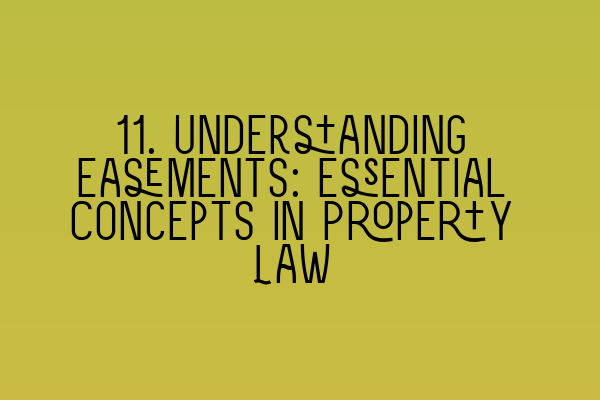Understanding Easements: Essential Concepts in Property Law
Welcome to another informative post by the experts at SQE Property Law & Land Law! In today’s article, we will be diving into the intricate world of property law and exploring the concept of easements. Whether you are a solicitor, law student, or simply interested in property law, this article will provide you with a comprehensive understanding of easements and their importance in property transactions.
What is an Easement?
An easement is a legal right that allows an individual to use another person’s land for a specific purpose. It grants the holder of the easement the right to access or use a portion of someone else’s property, even though they do not own the land. Easements are often created to provide necessary rights of way or to grant specific privileges to a property owner.
Common examples of easements include:
- Right of Way: This type of easement allows someone to pass through another person’s land to access their own property. It is commonly used for pathways, driveways, and shared access routes.
- Utility Easements: These easements give utility companies the right to install and maintain utility lines on privately-owned properties, such as gas, water, and electricity.
- Drainage Easements: Drainage easements allow the flow of water across a property to prevent flooding or water damage. They are often created to ensure proper water management in built-up areas.
Creating an Easement
There are several ways in which easements can be created:
- Express Grant: An easement can be specifically granted by the owner of the servient land through a legal document, such as a deed or contract.
- Implied Grant: In some cases, an easement may be implied through the actions and conduct of the parties involved. For example, if a landowner consistently allows his neighbor to use his driveway to access their property, a court may imply an easement.
- Prescription: A prescriptive easement is acquired through continuous and uninterrupted use of another person’s land for a specific duration of time. This is similar to adverse possession, but specifically relates to the use of land rather than claiming ownership.
Termination of Easements
Easements can be terminated or extinguished under certain circumstances:
- Agreement: The parties may agree to terminate an easement through a written agreement.
- Merger: If the dominant and servient properties are owned by the same person, the easement may be terminated through a merger of title.
- Abandonment: If the holder of the easement exhibits an intent to abandon it, such as through non-use for an extended period, it may be terminated.
It’s important to note that the termination of an easement should be properly documented to ensure clarity and prevent legal disputes in the future.
Conclusion
Easements play a vital role in property law, providing necessary rights and access to individuals and companies. Understanding the concept of easements is essential for property law professionals and anyone involved in real estate transactions.
We hope this article has shed light on the key concepts surrounding easements. For further preparation in property law or if you require assistance with SQE exams, consider exploring our SQE 1 Practice Exam Questions or SQE 1 Practice Mocks FLK1 FLK2. We also offer comprehensive SQE 2 Preparation Courses and SQE 1 Preparation Courses. Stay up-to-date and check out the latest SRA SQE Exam Dates to plan your professional journey.
For any legal queries or to consult with our experienced property law team, feel free to reach out to us at SQE Property Law & Land Law. We are here to assist you with all your property law needs!
